Paid user acquisition can be an intimidating topic for newcomers in Mobile Marketing. The technical barrier is high, the amount of ad networks, agencies, and technology providers is enormous, and the danger of fraud is omnipresent. While try-and-error in areas like App Store Optimization only costs time, the same approach might result in high costs in user acquisition.
But there is a good way to avoid many of these problems and get new app users also with low experience and limited marketing budgets: Universal App Campaigns (UACs)
In this guide, I will explain to you everything you need to know to run successful UACs:
- What are Universal App Campaigns?
- History and Success Story of UACs
- How do Universal App Campaigns work?
- Where can Universal App Campaigns run?
- Can Universal App Campaigns run on iOS?
- How to Set Up Universal App Campaigns
- Can UACs target specific Countries or Regions?
- Can UACs target specific Languages?
- Can UACs target specific Keywords?
- Can I set Goals for Universal App Campaigns?
- Budget and Bidding for Universal App Campaigns
- Creative Specs for Universal App Campaigns
WHAT ARE UNIVERSAL APP CAMPAIGNS?
Universal App Campaigns are an ad type in Google Ads based on machine-learning. They allow advertisers to promote their apps across various Google-owned channels. Google’s algorithms do the work of finding the best ad placements and optimizing the campaign’s performance, what makes UACs easy to set up and maintain for advertisers.
Read on to learn why these measures will boost your users’ retention.
HISTORY AND SUCCESS STORY OF UACS
UACs were a disruption for app promoters. Historically, they could use Google Ads (then Google Adwords) like SEA managers still use it: They could bid individually on single keywords that they considered relevant to their app. But shortly after the introduction of Universal App Campaigns in 2015, keyword bidding was made unavailable for apps. so UACs became the only option for running app install campaigns.
As Google’s new campaign type offers fewer options for active optimization and also is less transparent about placements, advertisers were and still are skeptical about it. However, Google proofed that its algorithms do a good job: Since 2015, advertisers have generated more than 17 billion app downloads using UACs. The cost per conversion is competitive and in many cases lower than the cost of other user acquisition channels such as RTB campaigns, while traffic quality is good.
HOW DO UNIVERSAL APP CAMPAIGNS WORK?
After a successful campaign setup, Google’s algorithm automatically tests ad placements across their inventory to find the users that match a campaign’s goal. For this purpose, it also uses different combinations of texts, images, and videos to determine the most promising creatives.
The advertiser does not do any optimization work besides adjustments of bids and daily budgets.
WHERE CAN UNIVERSAL APP CAMPAIGNS RUN?
As mentioned before, a Universal App Campaigns ad can appear in various placements:
- On search result pages in the Google Play Store. UACs are the only way to buy ad placements on SERPs, which makes them the counterpart for Apple Search Ads. You can identify UAC ads by the small bold “ad”-caption next to the app publisher’s name. In contrast to organic search results, all ads show a short caption above the average rating.
Learn more: BEST PRACTICES FOR APPLE SEARCH ADS – A GUIDE FOR BEGINNERS
- In search results on Google. When users perform a search using a mobile device, a UAC ad can appear on top of the Google SERP. It shows the app icon, the average rating, and the text elements defined by the advertiser.
- In search results on websites or apps that are Google Search Partners. These include, for instance:
- Google Maps
- Google Images
- Google Shopping
- Google Groups
- Site Directory Pages
- Search Results on eBay, Amazon, Walmart, or Target
- On YouTube. Banner ads including text elements and the app’s average rating can appear in the list of suggested videos. You can identify them by the yellow “ad”-badge in the bottom left corner. In addition, skippable or non-skipable video ads can show up in the video player, given you provided video assets when setting up the campaign.
- On websites and in apps across the Google Display Network. The Google Display Network is a group of more than 3 million websites and apps that reaches about 90% of internet users worldwide. Ads can appear in different sizes and formats as banner, video, or text ads.
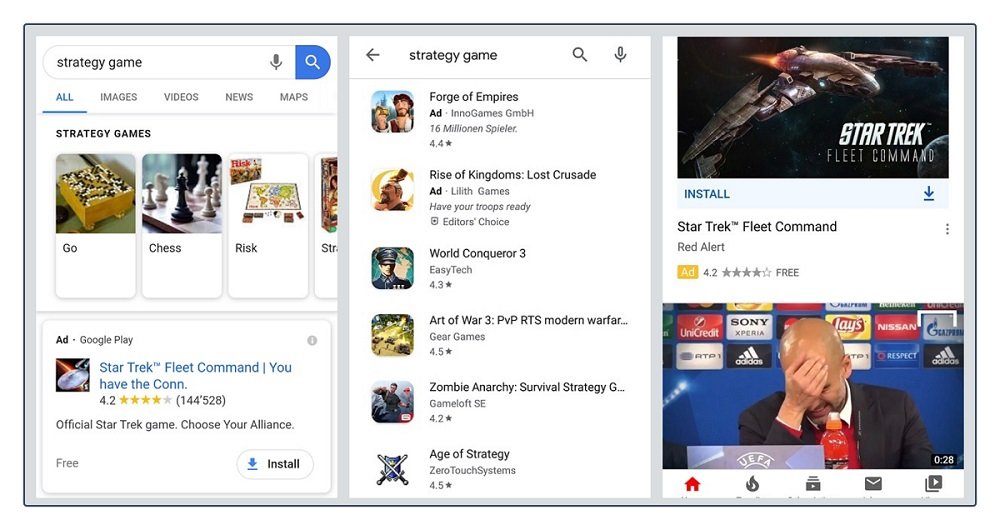
UAC Ads on Google SERP (left), Google Play SERP (middle), and YouTube (right)
CAN UNIVERSAL APP CAMPAIGNS RUN ON iOS?
In general, yes, UACs can run on iOS. However, as not all of the placements mentioned above are available, the reach of UACs on iOS is limited. For example, Google has no access to SERPs in Apple’s App Store, so ads cannot be displayed there.
HOW TO SET UP UNIVERSAL APP CAMPAIGNS
As mentioned before, the setup of UACs is rather easy.
First, create a new campaign: Select “app promotion campaign”, pick your app’s OS, and select its name from the list that Google provides.
Continue and give your campaign a proper name. The campaign name will appear in analytics tools like Google Analytics. Thus I suggest to pick a name that clearly identifies the campaign by app, OS, country, language, and campaign goal. For instance, a campaign for a Google Play (short: GP) app that targets English speakers (short: EN) in Canada and has the goal to drive as many installs as possible could be called:
Appname_GP_Canada_EN_CPI
Next, you need to provide this information:
- Geo-Targeting
- Language Targeting
- Campaign Goal
- Bid
- (Daily) Budget
- Start / End Date
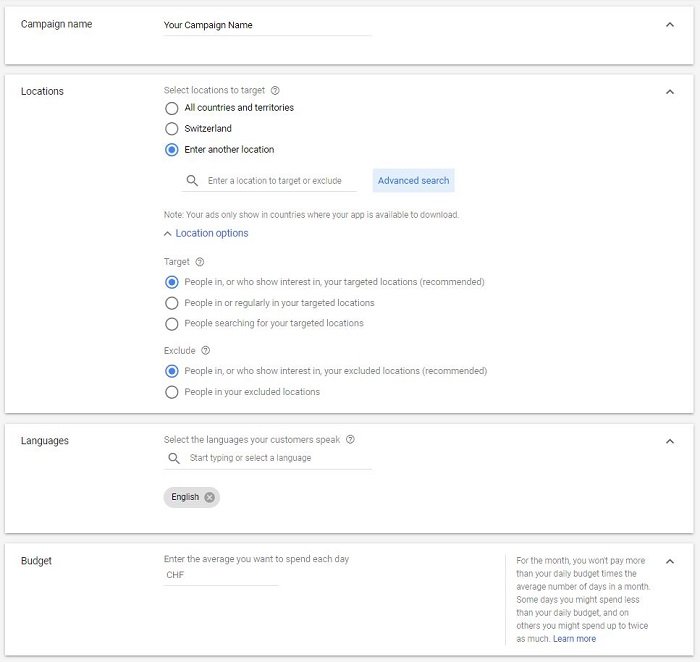
Campaign Setup Form for Universal App Campaigns
CAN UACS TARGET SPECIFIC COUNTRIES OR REGIONS?
Yes. You can target your campaign at one or more countries, provinces, or cities in the “Locations” section. In addition, you can also define exclude regions from your campaign. Follow these rules:- In general, avoid city-targeting. The bigger the target audience is, the easier will it be for the algorithm to find the right users for your app. With city-targeting, your potential audience will be too small. It only makes sense if your app provides services that people can only use in specific cities, for example, a restaurant app.
- Limit your targeting to one country per campaign, especially for industrial countries. In some cases, for instance, when countries are very small and only have a few inhabitants, it might make sense to target multiple countries, though. But in general, you should only run a campaign in one country.
- Only combine territories with the same (official) language. This is in particular important when running campaigns in multilingual countries. For instance, if you want to promote your app in Switzerland, create one campaign for people who speak German and one for French speakers. Exclude French-speaking territories from the German campaign (as shown in the figure below) and vice versa. Google will color targeted locations in blue and excluded regions in red.
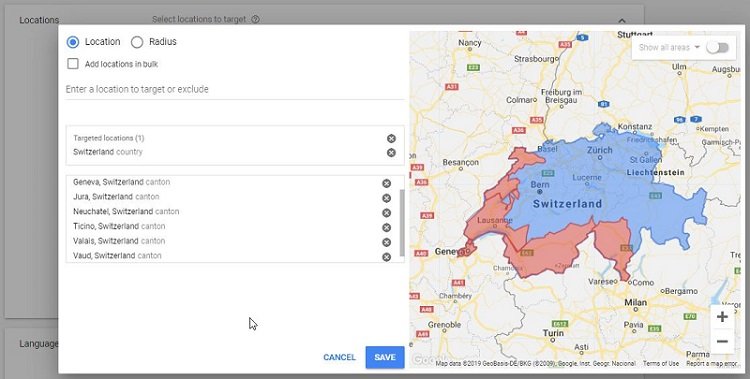
Location Targeting in Universal App Campaigns
CAN UACS TARGET SPECIFIC LANGUAGES?
Yes, you can target specific languages solely, or in addition to geo-targeting. Be aware that this targeting depends on the language that users set on their devices. So a native German-speaker that has his device set to English, will only see your ads if you target English.
CAN UACS TARGET SPECIFIC KEYWORDS?
No, keyword targeting is not possible with Google UACs, and neither is targeting specific ad publishers. Google’s algorithms decide where your ads appear.
However, you have one option to influence keyword targeting: Reach out to your Google Ads representatives and ask them to blacklist keywords that you do NOT want to target. Usually, they agree to exclude these terms from targeting, given it is a list of not more than 50 keywords. In some cases, exclusions are useful for brand keywords. For instance, if you have a cooperation with another app owner and do not want your ads to show up when users search for his brand name, blacklisting this name makes sense. For most apps, it does not make sense to limit your traffic with keyword exclusions, though.
CAN I SET GOALS FOR UNIVERSAL APP CAMPAIGNS?
Yes, you can define one of three goals for each campaign in the “bidding” section of the setup form:
You can focus purely on “install volume”. When picking this option, Google will deliver as many new users as possible without taking user quality into consideration.
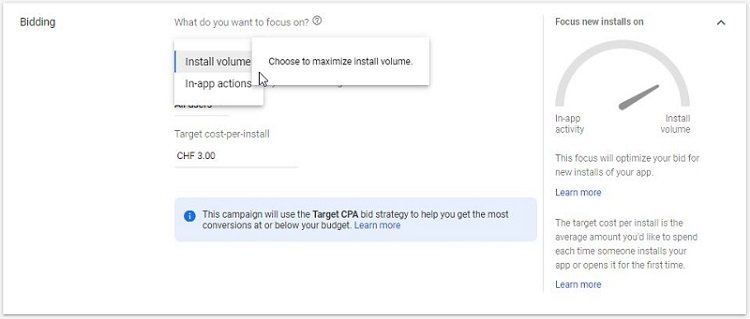
If volumes are your priority but you do not want to disregard user quality, select the additional option “Users likely to perform an in-app action”. You need to define the post-install event that the algorithm should use to optimize. Be aware that you can only use events that your attribution partner sends to Google as conversions (check them under “Tools & Settings” -> “Conversions”).
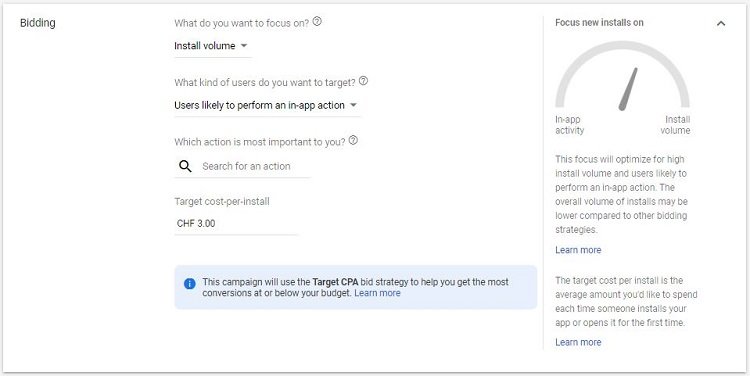
In case you want to focus on user quality over quantity, select “in-app actions”. You must define post-install events that matter to you too, but in contrast to option 2, you can pick more than one.
BUDGET AND BIDDING IN UNIVERSAL APP CAMPAIGNS
No matter which option you choose, you need to define a target CPA. That will be the average price per conversion that Google will try to reach. When the focus of your campaign is install volume (with or without the additional quality option), this will be a target CPI.
In any case, the target CPA is just a benchmark. You will actually pay based on clicks.
Your budget should depend on your campaign goals and on the target CPA you set. Follow these rules:
- For CPI campaigns: Budget = 50x Target CPI or more
- For CPA campaigns: Budget = 10x Target CPA or more
Be aware that these are daily budgets. You can not set an overall campaign budget. It might happen that Google spends more than your daily budget on single days. But the algorithm will decrease spendings for other days so that the average daily costs will not exceed the budget you define.
CREATIVE SPECS FOR UNIVERSAL APP CAMPAIGNS
For Universal App Campaigns, you can use text ads, static image ads, or video ads.
The only must-have assets are text ads. Google combines them with metadata elements from your app’s product page like the app title or the app icon to create ads for Google Search and Google Play. You have to provide at least 2 and up to 5 ideas for ad titles of 30 characters, and 1 to 5 additional lines of text with up to 90 characters each.
To show ads on the Display Network and YouTube, you can upload 20 images, 20 HTML ads, and link up to 20 YouTube videos to your campaign.
This table summarizes the specs for UAC creatives:
| Creative | Specs | Size / Length | Amount |
|---|---|---|---|
| Text Ad Title | Text | up to 30 Characters | 2 - 5 |
| Text Ad | Text | up to 90 Characters | 1 - 5 |
| Banner Ad | jpeg or png | Phone Sizes: 320 x 480 px 300 x 50 px 320 x 100 px 300 x 250 px 1200 x 628 px 320 x 50 px 480 x 320 px 728 x 90 px Tablet Sizes: 1024 x 768 px 768 x 1024 px | up to 20 |
| HTML Ad | same as Banner Ad | up to 20 | |
| Video Ad | any YouTube supported Format | up to 20 |
Best Practices for Text Ads:
- Create text ads that transport reasonable messages even when standing alone.
- Also, make sure that every combination of your text ads with each other and with text ad titles makes sense.
- Use CTAs to encourage users to click and test your app.
- Avoid using exclamation points. They might be the reason for Google to reject your ad. Use full stops instead.
Best Practices for Image Ads (and HTML Ads):
- Use simple designs with little text, especially for the smaller formats, so users get your app’s essence at a glance.
- Use assets from your app’s product page and branding elements (logo, unique characters), so users can recognize your app.
- Add Google Play Store or App Store badges to your images to clarify that the ad promotes an app.
- Include CTAs to encourage users to test your apps.
- Also, consider uploading images without text elements that can be shown in native placements.
- Create the same motif in different formats. This is especially useful if you already have identified a motif that generates extraordinary high conversion rates.
- For HTML ads, target a length of about 90 seconds.
Best Practices for Video Ads:
- Bring your core message across within the first seconds of the videos, before users have the chance to skip the ad.
- Use videos of different lengths and dimensions (landscape, portrait) so Google can test which version works best.
- Add Google Play Store or App Store badges to your videos (at least at the end) to clarify that the ad promotes an app.
- Provide videos in both landscape and portrait format, so Google can serve the right version for each placement.
- Create videos that transport their messages even when the user watches them in mute mode.
HOW TO OPTIMIZE UNIVERSAL APP CAMPAIGNS
I already mentioned that Google’s algorithms do most of the optimization work. As the advertiser, you only have limited options to impact campaign performance. Here are some tips to get the best out of your UACs:
- Do not target one location with multiple CPI campaigns. For instance, if you run a CPI campaign for the United States, do not start other CPI campaigns targeting single states like Florida or California. The campaigns would bid against each other and increase the prices you have to pay for new users.
- It is fine to run one CPI campaign and one CPA campaign that both target the same country. You can also run multiple CPA campaigns but they must optimize towards different events and address different user groups. For instance, you can run one campaign to increase the tutorial completion rate (focus on short term retention) and one to generate purchases (focus on monetization). But you should not run multiple purchase campaigns.
- Be patient. When you start a new campaign, it might take a couple of days, maybe even weeks until you see significant volumes coming in. The reason is that Google’s algorithm needs to test different placements to learn what works best for your ads. Google recommends not to do any changes until your campaign has at least 100 conversions.
- For the same reasons, the average CPI (or CPA) might be much higher than the target bids you defined. So do not panic when seeing high CPIs or CPAs at first. As soon as the algorithm finds the right ad placements, they will slowly come down to the target level.
- Check which ads perform best regularly. Eliminate those with low conversion rates, so you can add new text ideas and creatives for testing.
- Avoid significant changes in bids and budgets. Especially lowering the target CPI (or CPA) by 20% or more within 24 hours can harm the campaign performance in the long-term (even if you raise the bid back to the original level later). So if you need to lower bids, do it in small consecutive steps over a couple of days. For instance, decrease it by 5% every other day. The same rules apply to your daily budgets.
- In case, you have to stop a campaign or an error impacts its performance (like a tracking bug), rather create a new campaign than restart an old one. You can simply copy and paste it. The chance that a new campaign drives good results is higher than the chance that a low performing campaign recovers, even if the settings are identical.
CONCLUSION
Universal App Campaigns are a good way to start with paid user acquisition for every owner of an Android app. They are easy to set up and Google’s big reach guarantees good results. Unlike programmatic campaigns, UACs are suitable even for new apps that run on low budgets. Thus, UACs should be part of every app marketing plan.
Learn more: PROGRAMMATIC ADVERTISING AND REAL-TIME BIDDING FOR APPS
